Fragrant and nutty, this seeded sourdough bread is the perfect twist on a classic sourdough loaf. Leavened completely with sourdough starter, it’s packed with sesame and pumpkin seeds – perfect for toast or sandwiches!
I love a good no-knead sourdough loaf and this seeded sourdough bread is no exception. It’s full of sesame and pumpkin seeds for that perfect, nutty crunch – though you can use any mix of seeds that you’d like!
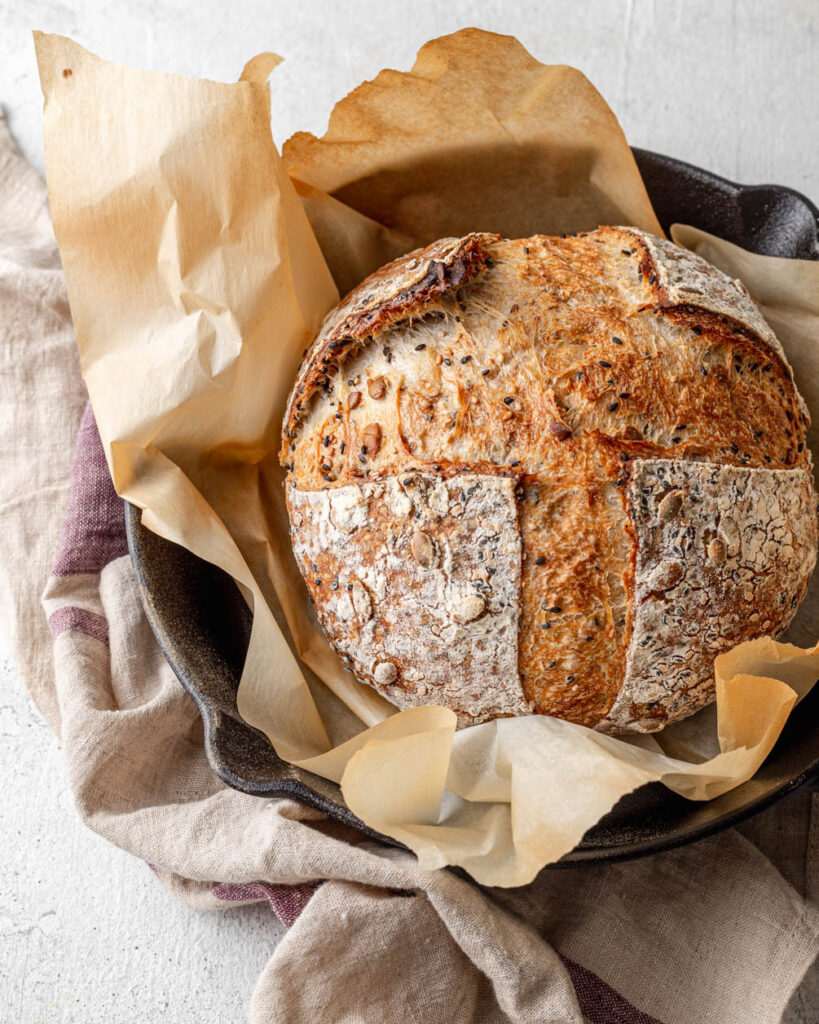
What kind of seeds can be added seeded sourdough bread?
You can really use any seeds that you like! I personally like a mix of sesame and pumpkin seeds. You could also use sunflower seeds, poppy seeds, or even chia seeds.
When using chia seeds in the past, I have let them soak ahead of time so that they don’t absorb water in the dough.
How to develop sourdough gluten without kneading
In general, I don’t like kneading my sourdough since the dough is high hydration and hard to handle. Because of the long, slow rise the gluten will naturally develop over time. To help that process, we’ll use an autolyse period, coil folds, and lamination to develop strength in the dough.
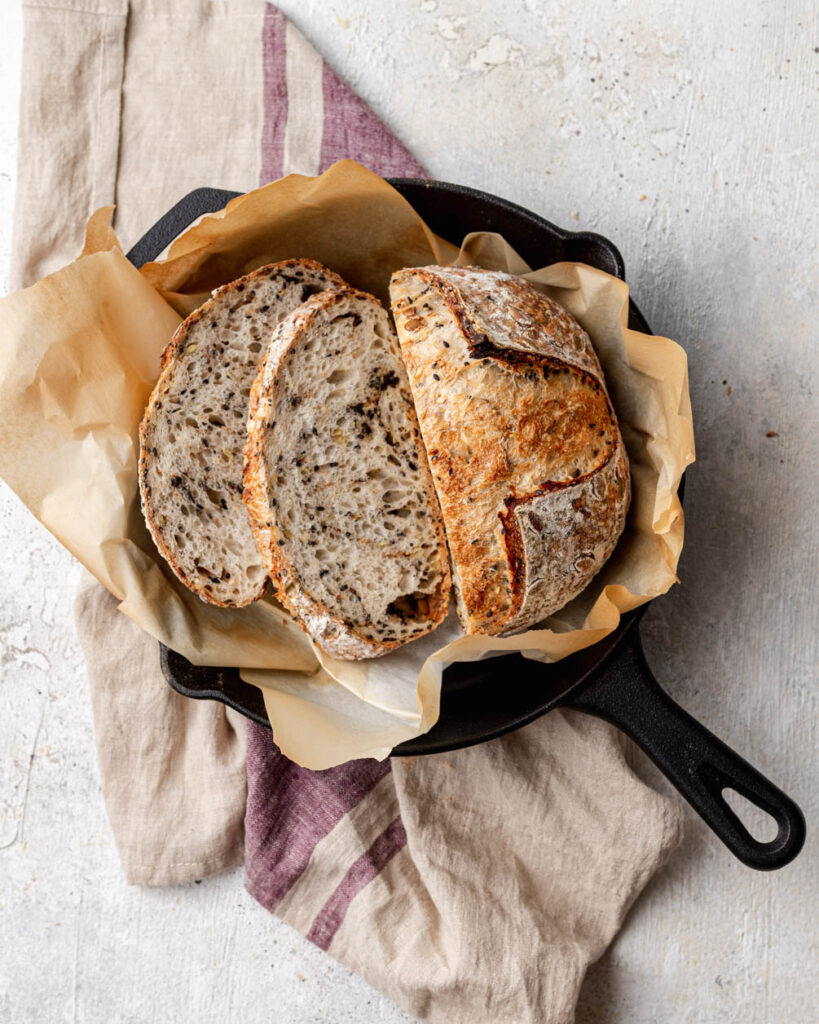
What is an autolyse?
Autolyse is when you mix together the flour and water and let it sit for 20 minutes and up to multiple hours. During this period, the dough becomes stretchier and more elastic, and gluten starts to develop. Traditionally, autolyse leaves out both the yeast and the salt, since salt inhibits the elasticity of the gluten. In this recipe, I mix in the starter along with the water for a “fermetolyse.”
What is a coil fold?
A coil fold is a way of gently stretching and folding the sourdough over itself to help develop the gluten. I do this once every 30 – 45 minutes for a total of 3 times. As you do more coil folds, you notice the dough developing strength, becoming smoother, and holding its shape.
What is sourdough lamination?
Laminating refers to gently stretching out the dough thinly to help develop the gluten. It’s also a great time to include add-ins, such as seeds since they’ll then become evenly distributed throughout the dough. It’s best to laminate early on in the fermentation process so that you don’t knock out too much air. However, you don’t want to add fillings too early, since it could inhibit the rise. In this recipe, I laminate after the second coil fold.
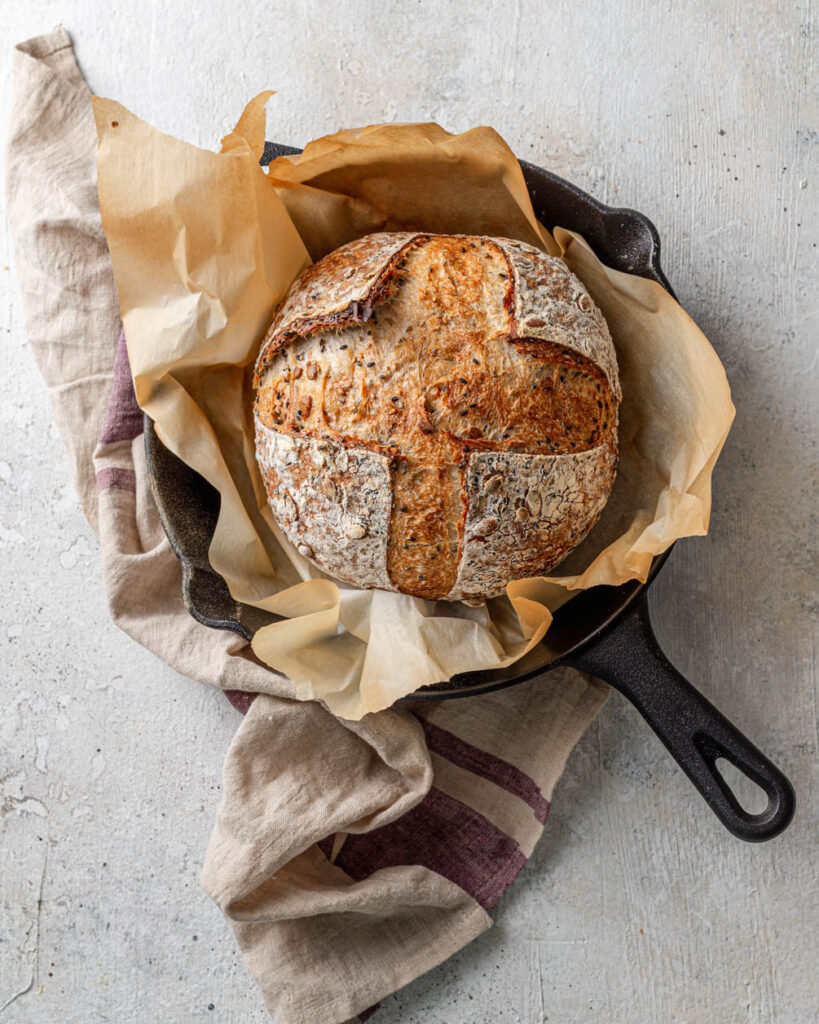
My process for making seeded sourdough
Day 1
10:00 am – Remove starter from the fridge and feed with 60g all-purpose flour and 60g water
1:00pm – Starter has grown about 2x in size. I start the autolyse by mixing the flour, water, and starter in a large bowl.
1:00pm – 1:30pm – Autolyse
1:30pm – Add salt and a little bit of water, mix in
2:00pm – First set of coil folds
2:30pm – Second set of coil folds
3:00pm – Laminate the dough and add seeds
3:45pm – Last set of coil folds
5:00pm – Shape into a boule and place into a bowl
8:00pm – Place in the fridge for an overnight cold retard
Day 2
10:00am – Pre-heat oven to 500F with uncovered Dutch oven inside.
10:45am – Score & bake for 25 minutes with lid on and then reduce to 450F and bake for 20 – 22 minutes with lid off.
3:00pm – Slice into loaf after it has thoroughly cooled.
Other sourdough recipes to try
- Sourdough milk bread cinnamon rolls
- Sourdough Japanese Milk Bread
- Pumpkin sourdough bread
- Honey oat sourdough bread rolls (no knead)
- Black sesame and red bean sourdough
If you make this recipe, let me know! You can comment below or tag me on Instagram @halicopteraway or #halicopteraway.
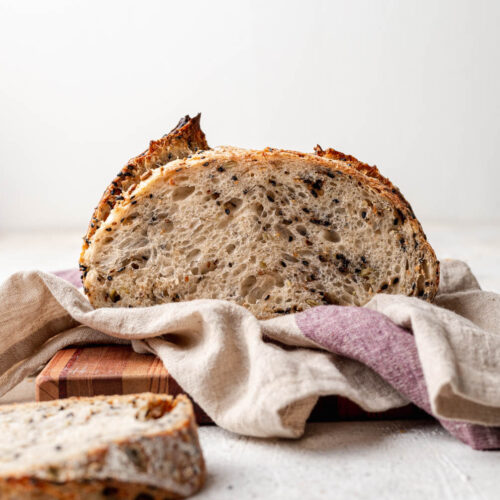
Seeded sourdough bread
Equipment
- Large mixing bowl
- Dutch oven (see notes if you do not have a Dutch oven)
- Bowl or proofing basket
- Food scale
Ingredients
For the dough
- 115g fed and active sourdough starter, 100% hydration
- 300g bread flour
- 205g lukewarm water
- 7g salt
For the seed mix
- 25g white sesame seeds
- 25g black sesame seeds
- 25g roasted pumpkin seeds, crushed
Instructions
- In a large mixing bowl, mix together the sourdough starter and 200g of water. Add the bread flour and mix until a shaggy dough forms. Cover and let sit for 30min to 1 hour
- Add the salt and 5g of water to the dough. Gently use your hands to fold in the salt. Cover and let sit for 30 – 45 min
- Perform your first coil fold. Wait 30 – 45 minutes more and perform your second coil fold.
- Mix together the sesame seeds and pumpkins seeds. Then, sprinkle a working surface with water to prevent sticking. Turn your dough onto the surface and very gently stretch until thin, without breaking the dough. It should be about 8 – 10 inches long on each side. Sprinkle the surface generously with the seed mixture. Fold the bottom edge of the dough towards the middle and sprinkle the exposed side with more seeds. Fold in the sides toward the middle, then fold down the top to create a rough ball. Place the dough back in the bowl and sprinkle with any of the remaining seeds. Cover and let sit for another 30 – 45 minutes.
- Perform the last coil fold, cover, and let sit for another 2 – 3 hours
- Line a medium bowl with a floured kitchen or paper towel. Lightly flour a working surface and turn the dough onto the surface. Gently shape into a boule and place it seam side up in the bowl. Let sit for another 2 – 3 hours. Periodically check on the dough to make sure it does not overproof.
- Cover with plastic wrap and place in the fridge for at least 8 hours and up to 48 hours.
- When you're ready to bake, preheat the oven to 500°F with your uncovered Dutch oven inside. Turn the dough onto floured parchment paper and score.
- Place the scored loaf in the Dutch oven and cover with the lid. Bake for 25 minutes. Remove the lid and reduce temperature to 450°F and bake for another 20 – 22 minutes until it makes a hollow noise when tapped.
- Remove from oven and let cool completely (about 2 hours) before slicing
Notes
- All my sourdough recipes are in grams only, because precision is extremely helpful for baking sourdough
-
If you don’t have a Dutch oven, you can use my no Dutch oven method: https://halicopteraway.com/2020/10/28/how-to-bake-sourdough-and-any-crusty-bread-without-a-dutch-oven/

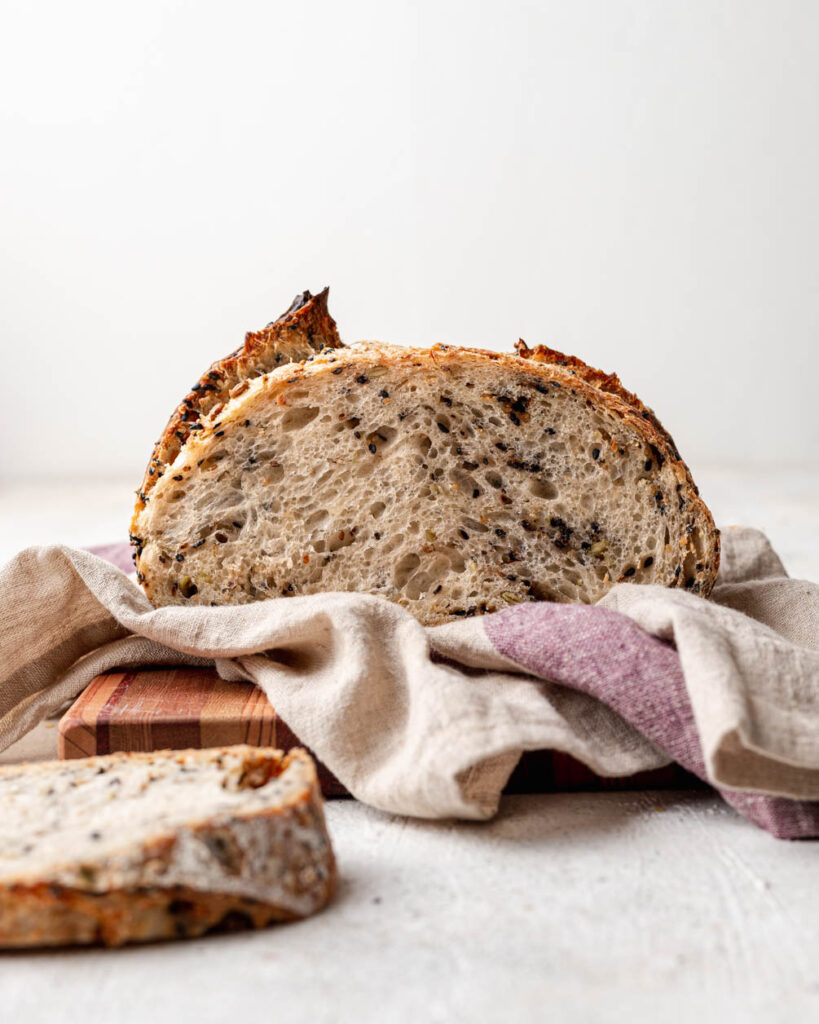
Hi Hali,
What is the temperature of your kitchen? Does the bread taste sour after fermenting on counter for 7-8 hours and retarding in fridge for 14 hours?
Hi June, my kitchen runs on the cool side, around 68-70F and my fridge is set to 35F. The bread doesn’t taste very sour, but this could also depend on your starter